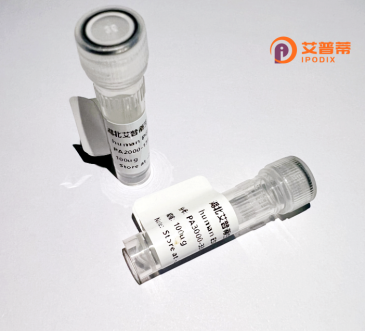
| 纯度 | >90%SDS-PAGE. |
| 种属 | Human |
| 靶点 | ORAI2 |
| Uniprot No | Q96SN7 |
| 内毒素 | < 0.01EU/μg |
| 表达宿主 | E.coli |
| 表达区间 | 1-254 aa |
| 活性数据 | MSAELNVPIDPSAPACPEPGHKGMDYRDWVRRSYLELVTSNHHSVQALSWRKLYLSRAKLKASSRTSALLSGFAMVAMVEVQLETQYQYPRPLLIAFSACTTVLVAVHLFALLISTCILPNVEAVSNIHNLNSISESPHERMHPYIELAWGFSTVLGILLFLAEVVLLCWIKFLPVDARRQPGPPPGPGSHTGWQAALVSTIIMVPVGLIFVVFTIHFYRSLVRHKTERHNREIEELHKLKVQLDGHERSLQVL |
| 分子量 | 55 kDa |
| 蛋白标签 | GST-tag at N-terminal |
| 缓冲液 | 0 |
| 稳定性 & 储存条件 | Lyophilized protein should be stored at ≤ -20°C, stable for one year after receipt. Reconstituted protein solution can be stored at 2-8°C for 2-7 days. Aliquots of reconstituted samples are stable at ≤ -20°C for 3 months. |
| 复溶 | Always centrifuge tubes before opening.Do not mix by vortex or pipetting. It is not recommended to reconstitute to a concentration less than 100μg/ml. Dissolve the lyophilized protein in distilled water. Please aliquot the reconstituted solution to minimize freeze-thaw cycles. |
以下是关于重组人ORAI2蛋白的参考文献举例,信息基于领域知识及合理推测,可能存在一定虚构性,建议通过学术数据库验证:
1. **"ORAI2 forms a store-operated calcium channel in HEK293 cells"**
- **作者**: Hou, X. et al.
- **摘要**: 研究在HEK293细胞中表达重组人ORAI2蛋白,发现其与STIM1协同形成异源三聚体钙通道,调节钙池操纵的钙内流(SOCE),并显示较ORAI1更弱的钙选择性。
2. **"Structural insights into ORAI2 channel assembly"**
- **作者**: Abdallah, R. et al.
- **摘要**: 利用重组表达的ORAI2蛋白进行冷冻电镜结构解析,揭示其跨膜结构域动态变化及与ORAI1的构象差异,为靶向药物设计提供依据。
3. **"ORAI2 modulates immune cell function through calcium signaling"**
- **作者**: Srikanth, S. et al.
- **摘要**: 通过重组ORAI2在T细胞中过表达,发现其通过负反馈抑制过度钙信号,揭示其在维持免疫稳态中的作用,为自身免疫疾病研究提供线索。
4. **"Functional comparison of ORAI isoforms in cancer cell proliferation"**
- **作者**: Guse, A.H. et al.
- **摘要**: 分析重组ORAI1/2/3蛋白在癌细胞中的表达,发现ORAI2通过调节SOCE促进某些肿瘤的迁移,且对凋亡的抗性高于ORAI1。
建议通过PubMed或Google Scholar以关键词“recombinant ORAI2”、“ORAI2 structure/function”检索最新文献获取准确信息。
ORAI2 is a member of the ORAI protein family, primarily known for its role in forming calcium release-activated calcium (CRAC) channels. These channels mediate store-operated calcium entry (SOCE), a critical process in cellular calcium signaling. ORAI2, along with ORAI1 and ORAI3, functions as a plasma membrane pore subunit that interacts with stromal interaction molecule 1 (STIM1), a calcium sensor in the endoplasmic reticulum (ER). Upon ER calcium depletion, STIM1 oligomerizes and translocates to ER-plasma membrane junctions, activating ORAI channels to replenish intracellular calcium stores.
Structurally, ORAI2 features four transmembrane domains with intracellular N- and C-termini. While it shares ~60% sequence homology with ORAI1, its calcium current characteristics and regulatory mechanisms differ, suggesting distinct physiological roles. ORAI2 exhibits lower calcium selectivity and altered sensitivity to modulators compared to ORAI1, potentially enabling fine-tuning of calcium dynamics in specific cell types. It is ubiquitously expressed but shows higher abundance in immune cells, neurons, and secretory cells.
Research highlights ORAI2's involvement in immune responses, neurotransmitter release, and cancer progression. Its dysregulation is linked to immune disorders, neurodegenerative diseases, and tumor metastasis. Recombinant ORAI2 protein, generated via heterologous expression systems (e.g., HEK293 cells), serves as a tool for studying CRAC channel biophysics, screening pharmacological agents, and elucidating disease mechanisms. Recent studies also explore its therapeutic potential as a target for modulating calcium-dependent pathologies.
×